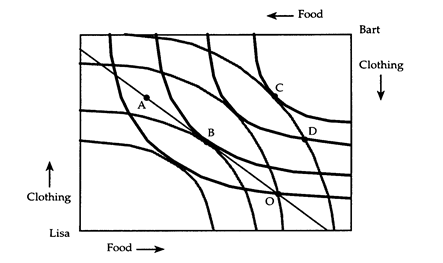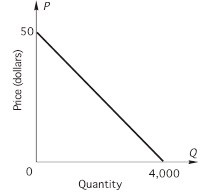Consider points A, B, C, and D shown in the accompanying Edgeworth box diagram.
(i) Which of these points do Bart and Lisa both prefer to the endowment point O?
(ii) Which of these points are Pareto optimal?
(iii) Which of these points are competitive equilibria? Justify your answers.

(i) Points A and B are Pareto-preferred to point O, because both points would put Lisa and Bart on higher indifference curves, so both points lie in the region of mutual advantage. A movement to point C or D would make Bart worse off, so these points are not Pareto-preferred to the initial endowment.
(ii) Points B and C are Pareto optimal because they lie where two indifference curves are tangent and thus lie on the contract curve. At points A and D, indifference curves are intersecting, so other points are Pareto-preferred to these allocations.
(iii) Point B is a competitive equilibrium-when the relative price of food equals the slope of the line drawn through point O, both Lisa and Bart choose point B, so the market clears and a competitive equilibrium is achieved.
You might also like to view...
The capture theory of regulation implies that
A) regulations promote the attainment of efficiency. B) regulations promote the attainment of economic profit. C) public officials favor voters over producers. D) the demand for regulation is less elastic than the supply.
Provide two circumstances where monopoly may offer efficiency advantages over competition.
What will be an ideal response?
According to the following figure, marginal revenue is zero at Q = ________.
A. 1,000 units B. 2,000 units C. 3,000 units D. 4,000 units E. none of the above
The U.S.'s high trade deficit must be balanced by:
A. high net capital outflows. B. low net capital outflows. C. net capital inflows. D. None of these statements is true.